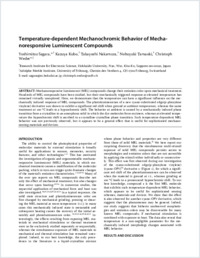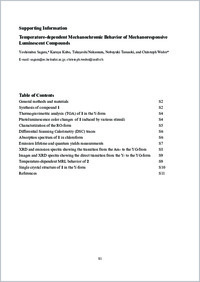Temperature-Dependent Mechanochromic Behavior of Mechanoresponsive Luminescent Compounds
- Sagara, Yoshimitsu Research Institute for Electronic Science, Hokkaido University
- Kubo, Kazuya Research Institute for Electronic Science, Hokkaido University
- Nakamura, Takayoshi Research Institute for Electronic Science, Hokkaido University
- Tamaoki, Nobuyuki Research Institute for Electronic Science, Hokkaido University
- Weder, Christoph Adolphe Merkle Institute, University of Fribourg
-
2017
Published in:
- Chemistry of Materials. - 2017, vol. 29, no. 3, p. 1273-1278
English
Mechanoresponsive luminescent (MRL) compounds change their emission color upon mechanical treatment. Hundreds of MRL compounds have been studied, but their mechanically triggered response at elevated temperature has remained virtually unexplored. Here, we demonstrate that the temperature can have a significant influence on the mechanically induced response of MRL compounds. The photoluminescence of a new cyano-substituted oligo(p-phenylenevinylene) derivative was shown to exhibit a significant red-shift when ground at ambient temperature, whereas the same treatment at 100 °C leads to a hypsochromic shift. The behavior at ambient is caused by a mechanically induced phase transition from a crystalline to an amorphous solid in which the dye molecules form excimers, whereas at elevated temperature the hypsochromic shift is ascribed to a crystalline–crystalline phase transition. Such temperature-dependent MRL behavior was not previously observed, but it appears to be a general effect that is useful for sophisticated mechano-sensing materials and devices.
- Faculty
- Faculté des sciences et de médecine
- Department
- AMI - Chimie des polymères et matériaux
- Language
-
- English
- Classification
- Chemistry
- License
-
License undefined
- Identifiers
-
- RERO DOC 289063
- DOI 10.1021/acs.chemmater.6b04720
- Persistent URL
- https://folia.unifr.ch/unifr/documents/305636
Other files
Statistics
Document views: 117
File downloads:
- Weder2017ChemMater: 342
- Weder2017ChemMater_SI: 142

